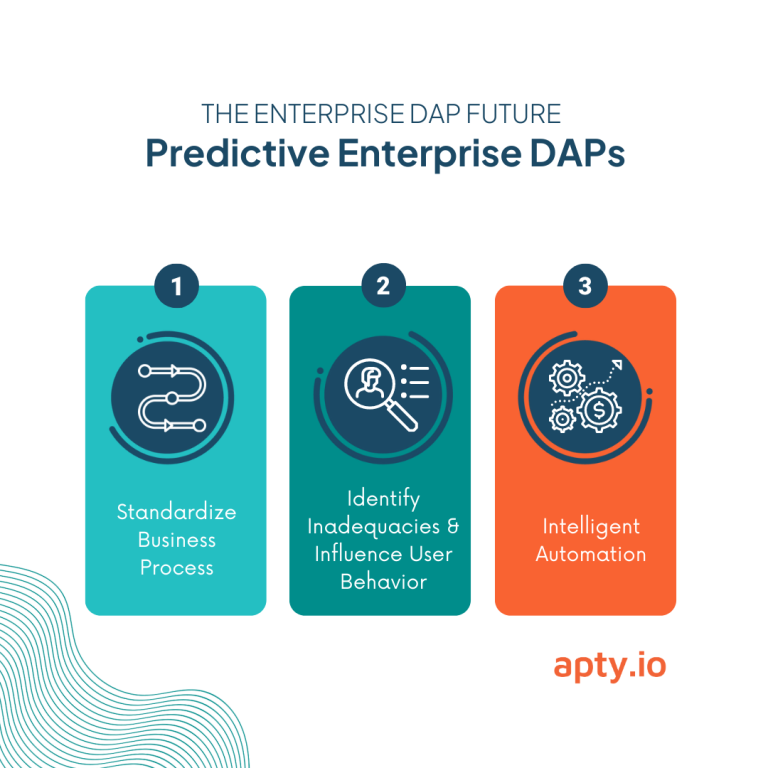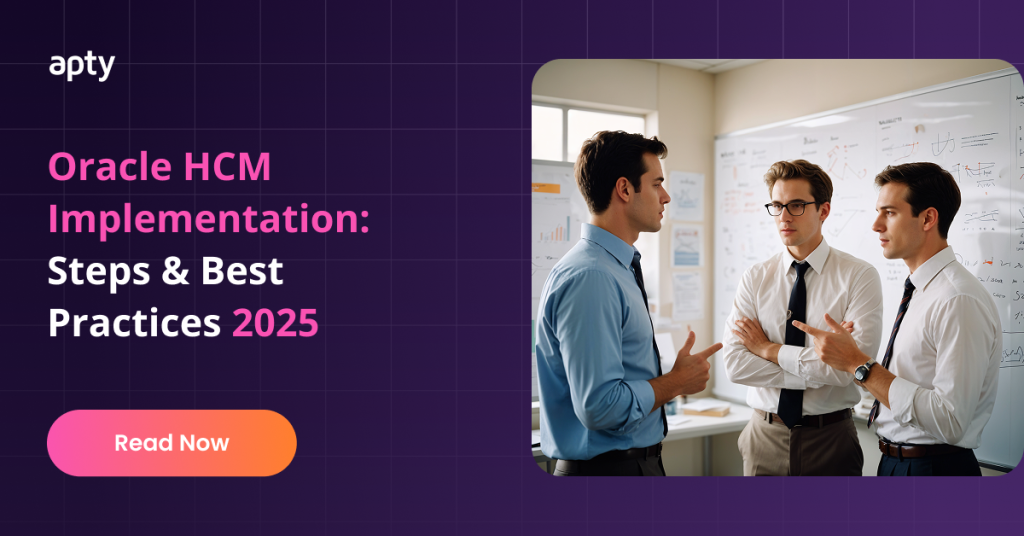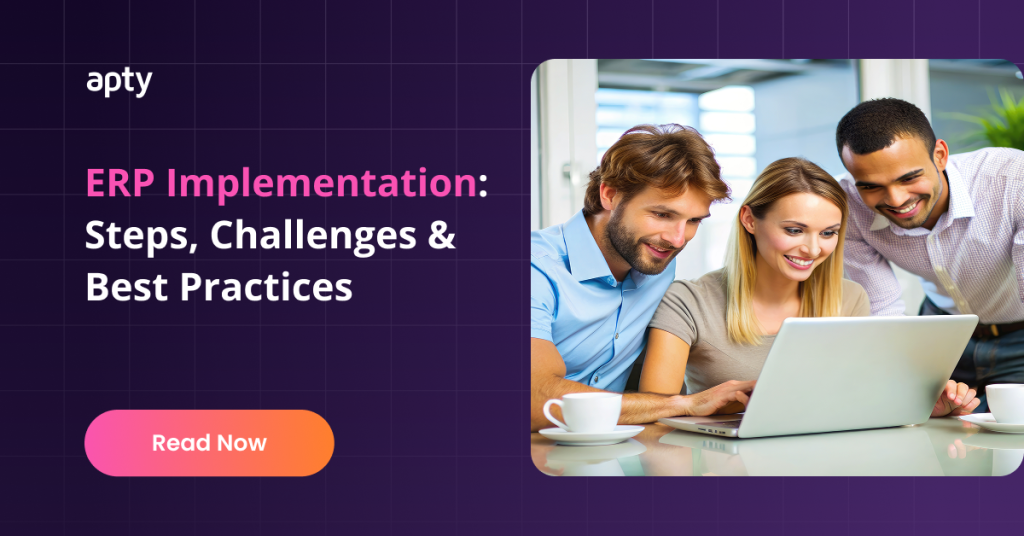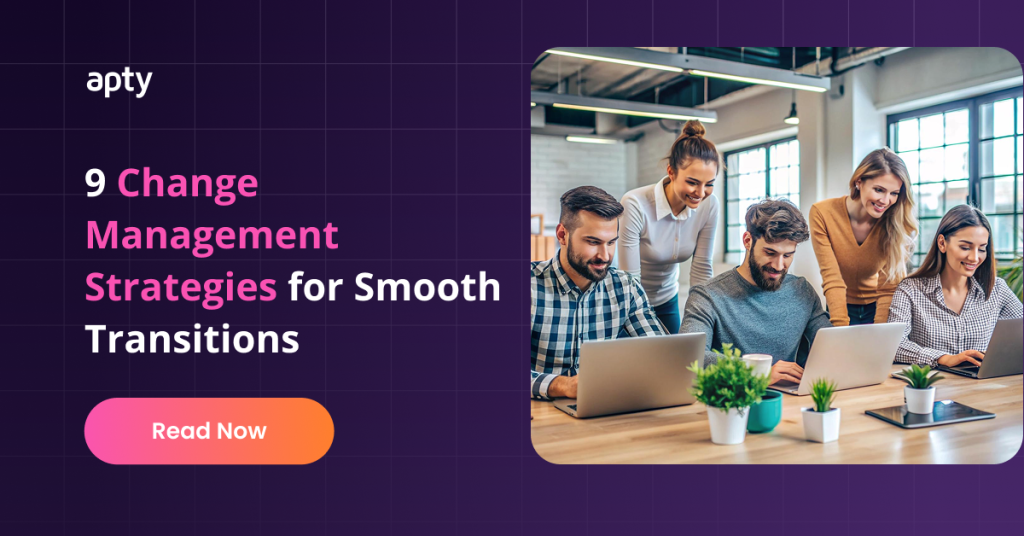The Future of Digital Adoption Platforms (DAPs)
An Apty Digital Transformation Series
The future of DAPs is tied to digital transformation and growing IT sectors. Digital adoption platforms (DAPs) are key to successful long-term digital transformation, according to ITPro Today. As stated by the tech blog and Gartner’s Senior Director Melissa Hilbert at Gartner’s Digital Workplace Summit in 2022, digital transformation depends on digital dexterity. Google states digital dexterity as “the ability for organizations and employees to pivot quickly using digital tools.” And that “digitally dexterous organizations are collaborative, think analytically, and make creative use of technology that can open up new possibilities for how work gets done.” Basically, using technology creatively to increase employee and software productivity.
But as technocratic leadership adds technical systems, SaaS apps, and integrations to gain productivity benefits, different problems arise. In the last 5 years, software solutions, technology, and digital advancements exploded exponentially as demand rose with the rise of remote workers and user expectations inflated with technological advancements and competition. CIOs face an influx of software “shelfware” and struggle to gain full software adoption with a positive software ROI. L&D is frustrated with content becoming outdated as soon as it’s published due to the increase in updates both with the software and business processes to keep up with business and digital transformations. And just like software “shelfware,” L&D departments are faced with learning content going underutilized or unused. And yet HR is faced with longer onboarding time cycles due to the sheer amount of platforms employees have to learn. DAPs have become key to filling the learning, tracking, and software gaps created by this evolving digital workforce.
With the implementation of an enterprise DAP into software rollouts, we’ve seen global clients onboard over 3 million users and achieve 90+% digital adoption within 90 days. As we continue to achieve high success rates, what does this mean for Apty and the DAP industry as a whole?
Evolution of the Enterprise DAP
In 2021-2022, independent research firms declared the digital adoption platform (DAP) industry its own distinct category and acknowledged the importance of its inclusion in digitally mature enterprise change management strategies. With the expansion of the industry, competition growth, and the tech industry’s direct impact on the need for DAPs to close the learning gap, data has accrued to predict the industry’s future.
The biggest question we hear from digitally mature enterprise clients after successfully completing a software rollout and digital adoption implementation strategy is…
“What’s Next?!”
After months of planning, purchasing, integrating, and developing the perfect enterprise software rollout, your implementation process is finally finished. You hope this business and digital transformation gives you oversight, insight, and control over enterprise productivity as promised. You thought ahead and tied a digital adoption platform (DAP) into the implementation process, and your KPI analytics now inform you that your users are 90-100% enabled with digital adoption complete. Bravo! Everyone’s relieved and excited, but what’s next?
Our enterprise software users are enabled; now what?
“If you’re only using a DAP for initial onboarding, then you’re doing it wrong!”
– Christopher Lind, ChenMed Chief Learning Officer
Customer Feedback:
“We are extremely happy with Apty, but What’s Next?”
– Global Conglomerate CIO
Additional Enterprise Software Challenges & Metrics to Consider in 2023
Some enterprises are lucky to have a software admin or change management center of excellence (CMCoE), or better yet, a digital center of excellence (DCoE), that owns and maintains your application. They are now charged with managing change during a tumultuous economy, hybrid workforce, fluctuating departments, and evolving business processes to account for the drastically escalated digital economy we’ve been given after the pandemic. With the abundance of new software lying around unused following a retired remote workforce and a teetering economy, your CIO, who’s cutting tech costs this year, may need additional metrics proving the worth of that software you just implemented. All this to say that there’s more to think about this year than others, and the tech boom has raised employee and customer expectations mixed with the reality that our departments are forced to do more with less with newly restricted budgets.
But even before the pandemic, we knew our enterprise software was destined for updates. We’ve gone from software updates every 3-5 years a decade or more ago to monthly releases to consider. The pandemic put digital transformations into hyperdrive and DAPs on the map. With SaaS releases at an all-time high, DAPs were initially implemented to fill learning gaps during implementation, onboarding, and virtual training. DAP features and capabilities grow as their integrations coincide with change management strategies, software implementation plans, and ensuring data integrity. By accelerating digital adoption and in turn digital transformation, DAPs secure an exciting future.
So, how can DAPs help your employees and software following a successful implementation?
Here are some potential areas to consider:
- Productivity
Identifying deviations > taking corrective actions = improving productivity - Measuring Success
Utilize available DAP KPIs - Process Standardization
Identify deviations > AUTOMATE those corrective actions = decrease reliance on users + increase productivity
Take the proactive and predictive information gained from your DAP and tie it back to business or digital transformation goals to drive revenue and informed decisions
The Takeaway: Defining the next phase in the digital adoption platform cycle…
“It’s time to connect the tracks to build something more intelligent and long-lasting for our clients… Digital Adoption Done Right!”
– Krishna Dunthoori, Founder & CEO of Apty
After enabling users we have other goals to achieve like productivity, benchmarking, process standardization and more.
Apty wrapped up its January 2023 SKO initiative, and one of the things that inspired our reps the most was the future of DAP and how it is becoming permanently woven into successful digital and business transformation initiatives.
Digital Adoption Platforms Past, Present, & Future: 2023 & Beyond
As software companies scale, expand, and transform, they are tiptoeing across thresholds and creating healthy competition with new features and digital initiatives across entire organizations. For example, Workday started in the HCM space but has since evolved and expanded its offerings to ERP and ITSM. Software is evolving from reactive to proactive features even in the DAP industry, separating SMB apps from the enterprise.
DAPs have allowed enterprise software to scale faster, accelerate digital adoption, and unify employee experiences across departments and platforms.
There are 3 types of DAPs: Reactive, Proactive, and Predictive.
Reactive DAPs
Basic DAPs offer reactive solutions like on-screen guidance for simple SaaS apps with surface-level assistance (ex. tooltips). This first tier of DAP helps enable users, teaching employees how to use the software. Users navigating the app interface encounter tooltips where and when needed. Admins can add tooltips to help new users understand fields and experienced users’ definitions for updated business processes. More advanced DAPs integrate multi-media and L&D training materials across the platforms, embedding and linking them in pop-ups or tooltips. This creates a co-partnership with L&D roles and business admins to ensure a more personalized and ongoing training experience.
When looking for a DAP, make sure even these basics are offered cross-applications for a streamlined end-user experience and in multiple languages to offer scalability globally. Most DAP tools fall into this reactive DAP category and are used as a once-and-done tool but do not enable ongoing business transformation.
Proactive Enterprise DAPs
Many illude to 2023 being the year of the DAP. Now that leading independent research firms recognized the tech category in 2022, the DAP future exponentially grew as competition drove transformations.
Enterprise DAPs generally fall into the next category: Proactive DAPs. Now that onboarding and enablement are complete, it’s time for process enforcement. As business processes change, department structures evolve, and enterprise software updates, business admins require real-time oversight, visibility, and control of their platforms to affect end-user behaviors according to the changing workplace. Easy to use and implement proactive DAPs came to fruition to give admins autonomy and ownership of their platforms, uncoupling them from delayed IT timelines and packed IT ticket lists. They also provide proactive analytics that gives insight into where employees are struggling with business processes, what processes are taking too long to complete, and where incorrect data is being input unchecked and degrading data. These enterprise DAPs, more importantly, prevent mistakes from happening with automated workflows or restricted pathways that require corrected input fields before allowing the user to proceed. After determining where and when mistakes are being made, these DAPs take it one step further by providing insightful targeted analytics as well as personalized messaging to targeted pre-defined user groups, locations, and/or specific users. You can send welcome messages with specifically triggered online training paths to new users, scheduled report and receipt reminders only to the North America sales team, or business process update reminders to those lagging in process adoption.
Enterprise DAPs offer:
- Onscreen guidance
- Virtual help desk
- Targeted messaging
- Digital mentor
- Personalized software experiences
- Individually paced self-help
- Proven knowledge retention
- Streamlined knowledge transfer
- Automated workflows
- Field validations for data quality control
- Reduced one-on-one training hours and costs
- Increased software adoption at scale
- Increased training material utilization
- Proactive analytics used to drive business-critical decisions
- Enriched tracking for software adoption KPIs
- User segmentation for personalized messaging, workflows, and analytics
With Proactive DAPs, you can…
- Increase employee engagement
- Gain department oversight, ownership, and autonomy
- Deliver reliable data to make data-informed decisions
- Create positive work experiences
- Reduce digital friction
- Increase software ROI
- Improve employee productivity
- Transform your change management strategy
- Accelerate digital transformation
Digital Adoption Platform Outlook
Both an FTH Research & Dataintelo Report mapped growth trends and market drivers for the global DAP industry, including, but not limited to:
- North America dominated the global market in terms of revenue share in 2019
- Asia Pacific regional market for digital adoption platform software is expected to see significant growth
- Growing demand for DAP software
- Increasing adoption of cloud-based software
- Integration with other software
- Growing IT Sector in Developing Economies
- Rising Number of Tools and Complex Operations
- Rising Need to Increase Productivity
- Remote workers
“The global digital adoption platform (DAP) software market is expected to grow from USD 1.02 Billion in 2022 to USD 3.73 Billion by 2030, at a Compound Annual Growth Rate (CAGR) of 16.2%.” – Dataintelo Report
Global DAP market trends show North America & the Asia Pacific regional market at the forefront of expansion.
Other independent research firms continue to track the growth of the DAP industry as we lead into an economic downturn. Although growth may slow slightly, we still see unanimous increases and adoptions of the software across enterprises in 2023 and beyond.
- Verified Market Research
- Market Growth Report
- A2Z Market Research – Digital Journal
- Dataintelo Report
The DAP Industry is Influenced by Economic & Technological Changes
This all coincides with and mirrors the expansion in markets like tech, AI, ML, digital transformation, and software. It also coincides with the movement toward remote and hybrid workforces in the past few years brought on by the CoViD pandemic. DAPs answer the learning curve gap that these new digital transformations and work environments bring.
Analytics shows that the DAP market is trending upwards with tech, AI, ML, and digital transformation markets showing correlation and a need to close the learning gap associated with this market increases.
With expansion comes resistance to change and adoption challenges. As hybrid work schedules become the workplace standard, economy shifts create uneasy predictions, and budgets fluctuate to reflect these changes, DAPs now close the gap of change management challenges and meet both ROI and benchmark needs for IT and business operations.
Your Software Rollout is Complete: Now What?
But DAPs are destined to do more.
Successful enterprise software adoption requires more than static tooltips, out-of-the-box templates, and basic user analytics. They aim to provide contextual in-app training when it’s needed, enable better process compliance, build proactive goal-based analytics, and eventually generate predictive algorithms from learned user behaviors that prevent mistakes and suggest solutions: digital orchestration.
Predictive Digital Adoption Platforms
This is digital adoption done right.

Predictive DAPs are thought to be “what’s next” in the DAP industry. It moves the needle one step closer to digital orchestration. As machine learning (ML), artificial intelligence (AI), and predictive technology enter the scene, DAPs will become more integral to enterprise scalability, productivity, and ultimately software adoption. DAPs will eventually be able to predict pathways, offer intuitive guidance or admin prompts based on past data, and provide intelligent and contextual insights. Analytics will also evolve with the ability to track past events and predict future events to prevent deviations. ChatGPT is already being woven into the enterprise DAP 2023 product releases for content creation and better search criteria.
The data-centric approach to understanding and correcting issues before they happen will profoundly affect data integrity, enterprise reporting, and business process compliance. DAPs could help department leaders ensure proper process completion and instantly improve employee productivity with intelligent automation. Predictive DAPs will predict future issues and suggest solutions, revolutionizing the software industry. Software partnerships are already underway to utilize DAP tools, understanding the importance and impact on their future success.
Predictive DAPs will become the future of this industry: enterprise digital adoption with automation and intelligent digital orchestration.
The future of enterprise DAPs has already been imagined, and we look forward to making it a reality.
This foreshadowing may hint at what’s next for both Apty and the DAP industry, but I’ll leave it here for now.
What will you expect from your digital adoption platform (DAP) in 2023 and beyond?
Stay tuned for the next blog in this series…
Table of Contents
- The Future of Digital Adoption Platforms (DAPs)
- An Apty Digital Transformation Series
- Evolution of the Enterprise DAP
- “What’s Next?!”
- Additional Enterprise Software Challenges & Metrics to Consider in 2023
- So, how can DAPs help your employees and software following a successful implementation?
- Digital Adoption Platforms Past, Present, & Future: 2023 & Beyond
- Reactive DAPs
- Proactive Enterprise DAPs
- Enterprise DAPs offer:
- With Proactive DAPs, you can…
- Digital Adoption Platform Outlook
- The DAP Industry is Influenced by Economic & Technological Changes
- Your Software Rollout is Complete: Now What? But DAPs are destined to do more.
- Predictive Digital Adoption Platforms This is digital adoption done right.
- What will you expect from your digital adoption platform (DAP) in 2023 and beyond?
- Want To Learn More About The Apty Enterprise Dap?
- Oracle HCM Implementation: Steps & Best Practices 2025
- ERP Implementation: Steps, Challenges & Best Practices
- 9 Change Management Strategies for Smooth Transitions





